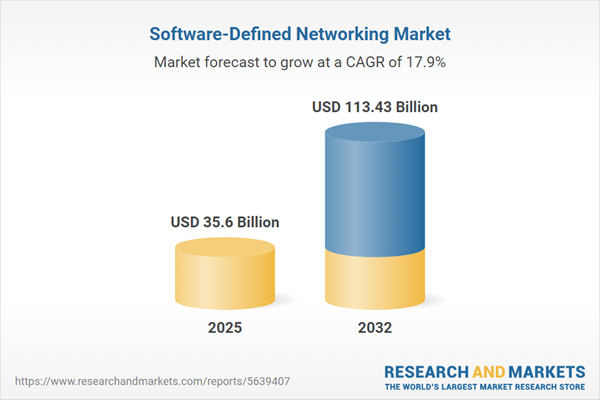Speak directly to the analyst to clarify any post sales queries you may have.
Software-Defined Networking (SDN) is transforming how enterprises deliver agility, security, and innovation within complex network infrastructures. As organizations face mounting demands from digital transformation and evolving business environments, SDN emerges as a pivotal solution for advanced programmability, centralized management, and adaptation to modern applications.
Market Snapshot: Software-Defined Networking Market Size and Growth
The Software-Defined Networking market grew from USD 30.37 billion in 2024 to USD 35.60 billion in 2025, and is projected to expand at a CAGR of 17.90%, reaching USD 113.43 billion by 2032. This growth reflects broad adoption across enterprises seeking greater flexibility, efficient deployment models, and robust security capabilities.
Scope & Segmentation
- Component:
- Managed Services
- Professional Services
- SDN Analytics Solutions
- SDN Applications
- SDN Controllers
- SDN Security Solutions
- SDN Switches & Routers
- Model Type:
- API SDN
- Hybrid Model SDN
- Open SDN
- Overlay Model SDN
- Architecture:
- Centralized
- Distributed
- Deployment Model:
- Cloud Based
- On Premise
- Enterprise Size:
- Large Enterprises
- Small & Medium Enterprises (SMEs)
- End-User:
- Banking, Financial Services, and Insurance
- Education
- Energy & Utilities
- Government & Defense
- Healthcare
- Manufacturing
- Retail
- Telecommunications & IT
- Region:
- Americas (United States, Canada, Mexico, Brazil, Argentina, Chile, Colombia, Peru)
- Europe, Middle East & Africa (United Kingdom, Germany, France, Russia, Italy, Spain, Netherlands, Sweden, Poland, Switzerland, United Arab Emirates, Saudi Arabia, Qatar, Turkey, Israel, South Africa, Nigeria, Egypt, Kenya)
- Asia-Pacific (China, India, Japan, Australia, South Korea, Indonesia, Thailand, Malaysia, Singapore, Taiwan)
- Major Companies:
- Allied Telesis Holdings K.K
- Arista Networks, Inc.
- Broadcom Inc.
- CDW LLC
- Ciena Corporation
- Cisco Systems, Inc.
- Dell Inc.
- Extreme Networks, Inc.
- F5, Inc.
- Fortinet, Inc.
- Fujitsu Limited
- Google LLC by Alphabet Inc.
- HEWLETT PACKARD ENTERPRISE COMPANY
- Huawei Technologies Co., Ltd.
- Infosys Limited
- International Business Machines Corporation
- Juniper Networks, Inc.
- Kyndryl Holdings, Inc.
- Lenovo Group Limited
- Microsoft Corporation
- NEC Corporation
- Nippon Telegraph and Telephone Corporation
- Nokia Corporation
- NVIDIA Corporation
- Oracle Corporation
- Palo Alto Networks, Inc.
- Pica8 Software Inc.
- Telefonaktiebolaget LM Ericsson
- Wipro Limited
Key Takeaways for Senior Decision-Makers
- SDN empowers organizations to increase agility, streamline network policy enforcement, and accelerate deployment of new services.
- Centralized management and automation help address the challenges of rising data volumes and diverse traffic patterns.
- Programmable networks support rapid integration of new technologies and provide the adaptability crucial for digital transformation.
- Security and compliance requirements are addressed through real-time policy controls and advanced threat mitigation strategies.
- Flexible deployment models help enterprises balance legacy infrastructure with modernization initiatives.
- Regional and vertical nuances in adoption drivers necessitate tailored strategies for optimal value creation in distinct business environments.
Tariff Impact: Navigating Sourcing and Supply Chain Disruption
Recent United States tariff policies on networking hardware are impacting procurement costs and sourcing decisions across global supply chains. Organizations must adapt by exploring alternative suppliers, domestic production partnerships, and modular hardware platforms. Service providers are adopting flexible consumption models to counter increased capital expenditures, while collaborative industry efforts are underway to navigate compliance and secure critical infrastructure availability.
Methodology & Data Sources
This research integrates primary data from industry interviews and surveys with secondary analysis of technical publications, regulatory documents, and vendor reports. Triangulation of qualitative and quantitative insights ensures depth and reliability, while expert panels validate assumptions for market accuracy.
Why This Report Matters
- Provides actionable, data-driven insights for strategic SDN investments and network modernization initiatives.
- Equips decision-makers with regional and segment-specific analysis to inform technology roadmaps and procurement strategies.
- Delivers credible intelligence on competitive landscapes, operational best practices, and evolving risk factors for long-term success.
Conclusion
This report enables technology leaders to make informed, confident decisions in navigating SDN transformation and capturing value from next-generation networking solutions. Leverage these insights to future-proof infrastructure and enhance operational resilience.
Additional Product Information:
- Purchase of this report includes 1 year online access with quarterly updates.
- This report can be updated on request. Please contact our Customer Experience team using the Ask a Question widget on our website.
Table of Contents
3. Executive Summary
4. Market Overview
7. Cumulative Impact of Artificial Intelligence 2025
List of Figures
Samples

LOADING...
Companies Mentioned
The key companies profiled in this Software-Defined Networking market report include:- Allied Telesis Holdings K.K
- Arista Networks, Inc.
- Broadcom Inc.
- CDW LLC
- Ciena Corporation
- Cisco Systems, Inc.
- Dell Inc.
- Extreme Networks, Inc.
- F5, Inc.
- Fortinet, Inc.
- Fujitsu Limited
- Google LLC by Alphabet Inc.
- HEWLETT PACKARD ENTERPRISE COMPANY
- Huawei Technologies Co., Ltd.
- Infosys Limited
- International Business Machines Corporation
- Juniper Networks, Inc.
- Kyndryl Holdings, Inc.
- Lenovo Group Limited
- Microsoft Corporation
- NEC Corporation
- Nippon Telegraph and Telephone Corporation
- Nokia Corporation
- NVIDIA Corporation
- Oracle Corporation
- Palo Alto Networks, Inc.
- Pica8 Software Inc.
- Telefonaktiebolaget LM Ericsson
- Wipro Limited
Table Information
| Report Attribute | Details |
|---|---|
| No. of Pages | 196 |
| Published | October 2025 |
| Forecast Period | 2025 - 2032 |
| Estimated Market Value ( USD | $ 35.6 Billion |
| Forecasted Market Value ( USD | $ 113.43 Billion |
| Compound Annual Growth Rate | 17.9% |
| Regions Covered | Global |
| No. of Companies Mentioned | 30 |









